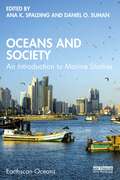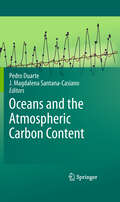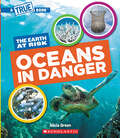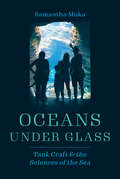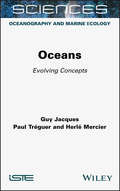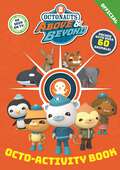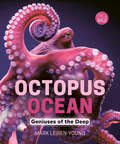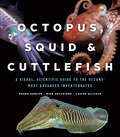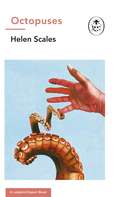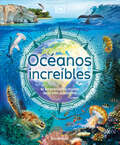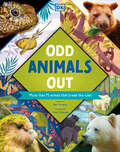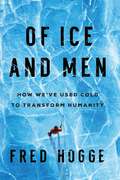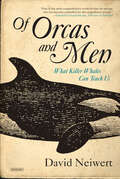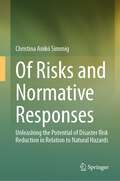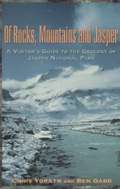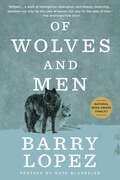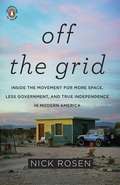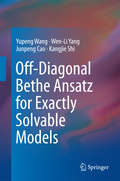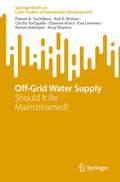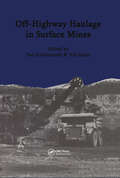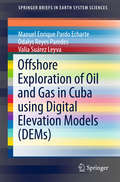- Table View
- List View
Oceans and Society: An Introduction to Marine Studies (Earthscan Oceans)
by Ana K. SpaldingThis unique textbook presents an introduction to the interdisciplinary field of marine studies, exploring the dynamic relationship between people and the marine environment. Emphasizing the human dimension of coastal and ocean issues, the book provides an innovative examination of the complex marine–human environment dynamics by drawing on social science and humanities approaches. Applying these interdisciplinary approaches, the textbook addresses key challenges facing the marine environment, including changing climate, fisheries, aquaculture, marine pollution, energy production, and management of areas beyond national jurisdiction. While leading with a human dimension approach to these challenges, the chapters are all firmly grounded in foundational knowledge about coastal and ocean environments and processes. The textbook also includes examples of professional or academic areas of specialization within marine studies such as social and environmental justice, governance, global perspectives, traditional ecological knowledge and management, entrepreneurship, community development, conservation, and the blue economy. Ultimately, the book provides the first cohesive resource on marine studies to educate students, train interdisciplinary marine leaders, inspire new knowledge about people and the sea, generate innovative solutions for sustainable oceans, and build capacity for a new generation of marine-focused professionals. Oceans and Society is essential reading for students on marine studies courses, as well as those studying marine governance, policy, conservation, and law more broadly. It will also be of great interest to students, researchers, and professionals interested in applying interdisciplinary approaches to environmental challenges.
Oceans and the Atmospheric Carbon Content
by J. Magdalena Santana-Casiano Pedro DuarteOceans and the Atmospheric Carbon Content, presents an interdisciplinary overview of the role of the oceans as a carbon sink and its relation with pH increasing trends and climate change. This volume discusses topics such as: climate variability during the last deglaciation, based on a high-resolution pollen analysis; the potential impact of CO2 from large metropolitan areas over the adjacent coastal zones and the importance of having high resolution atmospheric CO2 data to estimate accurately air-sea CO2 exchanges; present- day CO2 fluxes in the coastal ocean and their potential feedbacks under global climate change; phytoplankton community responses to climate change with emphasis on decreasing pH trends in sea water and its ecological effects; pH decrease and its effects on sea-water chemistry from a ten year time-series; the effect of acidification on metal bioaccumulation; the effects of increasing temperatures and acidification on contaminant dynamics and availability to biota; the prevention of potential environmental impacts related to the geological sequestration of CO2. The book provides an updated synthesis of current concerns related to global change trends in the oceans with a strong emphasis on acidification. The content draws attention to the importance of dealing with observed global change trends and their effects upon the oceans using an interdisciplinary approach due to their complexity and interlinks between different areas of knowledge.
Oceans in Danger (A True Book (Relaunch))
by Alicia GreenDiscover the rich biodiversity of Earth's biomes - and how they might be saved - with this STEAM-based subset of True Books.Did you know that Earth's five major oceans are all part of one giant global ocean? This biome is also home to the smallest animals on the planet - and the largest! Get ready to investigate Earth's mysterious ocean ecosystems, as well as the plants and animals that have adapted to survive in them. You'll also learn about the many threats facing this fascinating biome - and what each of us can do to help - all in the pages of Oceans in Danger.ABOUT THE SERIES:There are five major biomes on Earth: desert, forest, grassland, aquatic, and tundra. These rich, wild places are home to a wide variety of plants and animals - many of which are found nowhere else. Unfortunately, these ecosystems have been put at risk by human activities. This STEAM-based set of True Books introduces students to the incredible biodiversity of Earth's amazing biomes, as well as the threats they face in the era of climate change. Interesting information is presented in a fun, friendly way - and in the simplest terms possible - and will inspire kids to think about how they can help stop the destruction of Earth's wild spaces.
Oceans in Decline
by Sergio RossiWhat is happening in our oceans? By describing their main elements, this book shows how and why the oceans are being transformed, and suggests possible future scenarios to address this complex, yet often-asked, question. The ocean is being dramatically transformed, but the magnitude of this transformation remains unclear since the ocean is largely inaccessible and still unknown: there is more information about the outer universe than about the deepest parts of our oceans. The author, a marine biologist with extensive research experience, offers a holistic view of our oceans. Focusing on fishing, pollution and the effects of climate change, he identifies and describes the changes occurring in all marine ecosystems, and discusses the long-passed state of equilibrium.
Oceans under Glass: Tank Craft & the Sciences of the Sea (Oceans in Depth)
by Samantha MukaA welcome dive into the world of aquarium craft that offers much-needed knowledge about undersea environments. Atlantic coral is rapidly disappearing in the wild. To save the species, they will have to be reproduced quickly in captivity, and so for the last decade conservationists have been at work trying to preserve their lingering numbers and figure out how to rebuild once-thriving coral reefs from a few survivors. Captive environments, built in dedicated aquariums, offer some hope for these corals. This book examines these specialized tanks, charting the development of tank craft throughout the twentieth century to better understand how aquarium modeling has enhanced our knowledge of the marine environment. Aquariums are essential to the way we understand the ocean. Used to investigate an array of scientific questions, from animal behavior to cancer research and climate change, they are a crucial factor in the fight to mitigate the climate disaster already threatening our seas. To understand the historical development of this scientific tool and the groups that have contributed to our knowledge about the ocean, Samantha Muka takes up specialty systems—including photographic aquariums, kriesel tanks (for jellyfish), and hatching systems—to examine the creation of ocean simulations and their effect on our interactions with underwater life. Lively and engaging, Oceans under Glass offers a fresh history about how the aquarium has been used in modern marine biology and how integral it is to knowing the marine world.
Oceans: Evolving Concepts (Ioc Ocean Forum Ser.)
by Guy Jacques Paul Tréguer Herlé MercierSince the HMS Challenger expedition of 1872–1876, our vision of the ocean has changed completely. We now understand that it plays a key role in biodiversity, climate regulation, and mineral and biological resources, and as such, the ocean is a major service provider for humanity. Oceans draws on data from new oceanographic and satellite tools, acquired through international interdisciplinary programs. It describes the processes that control how the ocean functions, on different spatial and temporal scales. After considering the evolution of concepts in physical, chemical and biological oceanography, the book outlines the future of a warmer, acidified, less oxygenated ocean. It shows how a view of the ocean at different scales changes how we understand it. Finally, the book presents the challenges facing the ocean in terms of the exploitation of biological and mineral resources, in the context of sustainable development and the regulation of climate change.
Octo-Activity Book (Octonauts Above & Beyond #99)
by Official OctonautsThe Octonauts are on a global mission - on land! Enlisting their intrepid friends from around the world as Octo-agents - and equipped with a new fleet of land-based Terra Gups - the Octonauts' work is as vital as ever. They explore far-flung environments, rescue animals that need their help and protect the land and all living creatures.Featuring everyone's favourites from the original series, such as Captain Barnacles and Kwazii Cat, OCTONAUTS ABOVE & BEYOND introduces lovable characters like Paani, the water scientist monkey as they learn all about new environments, endangered animals, protecting habitats and more.Did you know...?- Bearded dragons are equipped with armour of spiny reptilian scales, which include a "beard" of spikes under its chin that puffs up depending on its mood.- Most crabs live in the ocean, but desert crabs live in tunnels under the ground and only come out at night when it's cool.- Antarctica is a cold desert that gets little snow and even less rain.The Octo-Report Fact and Activity Book is full of information about the amazing creatures and habitats featured in the episodes, and includes fun puzzles, mazes, games and activities pertaining to them.
October Sky
by Homer H. HickamThe true story, originally published as Rocket Boys, that inspired the Universal Pictures film. It was 1957, the year Sputnik raced across the Appalachian sky, and the small town of Coalwood, West Virginia, was slowly dying. Faced with an uncertain future, Homer Hickam nurtured a dream: to send rockets into outer space. The introspective son of the mine's superintendent and a mother determined to get him out of Coalwood forever, Homer fell in with a group of misfits who learned not only how to turn scraps of metal into sophisticated rockets but how to sustain their hope in a town that swallowed its men alive. As the boys began to light up the tarry skies with their flaming projectiles and dreams of glory, Coalwood, and the Hickams, would never be the same.
Octopus Ocean: Geniuses of the Deep (Orca Wild)
by Mark Leiren-Young★“Vivid and fascinating...Budding scientists and animal lovers will keep this stellar title in full-circulation as they learn the mysteries and history of octopuses.”—School Library Journal, starred review With their blue blood, big brains and eight arms, octopuses are dramatically different from any other being. Octopuses are masters of camouflage and known for their incredible escapes from tight spots. New research shows that they are highly intelligent creatures, and while they prefer to be alone, they will interact with humans and display unique personality traits. In Octopus Ocean, discover the mysteries and histories of octopuses big and small—their biology, habitat and habits—and explore the top threats to their future, including warming oceans, over-fishing and pollution. The epub edition of this title is fully accessible.
Octopus, Squid & Cuttlefish: A Visual, Scientific Guide to the Oceans' Most Advanced Invertebrates
by Roger Hanlon Louise Allcock Michael Vecchione“Cephalopods are often misunderstood creatures. Three biologists set the record straight on the behaviors and evolution of these invertebrates of the sea.” —Science NewsLargely shell-less relatives of clams and snails, the marine mollusks in the class Cephalopoda—Greek for “head-foot” —are colorful creatures of many-armed dexterity, often inky self-defense, and highly evolved cognition. They are capable of learning, of retaining information—and of rapid decision-making to avoid predators and find prey. They have eyes and senses rivaling those of vertebrates like birds and fishes, they morph texture and body shape, and they change color faster than a chameleon. In short, they captivate us.From the long-armed mimic octopus—able to imitate the appearance of swimming flounders and soles—to the aptly named flamboyant cuttlefish, whose undulating waves of color rival the graphic displays of any LCD screen, there are more than seven hundred species of cephalopod. Featuring a selection of species profiles, Octopus, Squid, and Cuttlefish reveals the evolution, anatomy, life history, behaviors, and relationships of these spellbinding animals. Their existence proves that intelligence can develop in very different ways: not only are cephalopods unusually large-brained invertebrates, they also carry two-thirds of their neurons in their arms. A treasure trove of scientific fact and visual explanation, this worldwide illustrated guide to cephalopods offers a comprehensive review of these fascinating and mysterious underwater invertebrates—from the lone hunting of the octopus, to the social squid, and the prismatic skin signaling of the cuttlefish.“After reading about the cephalopods’ abilities and behaviors, as well as their potential for advancing our lives, readers might think twice before ordering their next calamari appetizer.” —American Scientist
Octopuses: A Ladybird Expert Book (The Ladybird Expert Series #32)
by Dr Helen ScalesPart of the ALL-NEW LADYBIRD EXPERT SERIES- Why is it octopuses, and not octopi or octopodes?- How did octopuses evolve to be so clever?- How can octopuses see and speak with their skin? EXAMINE these crafty hunters of the seabed - shape-shifting, skin-signalling and using complex tools - their remarkable abilities are still being uncovered.BENDY BODIES, BIG BRAINSWritten by celebrated marine biologist and documentarian Helen Scales, Octopuses is an enthralling introduction to these utterly unique creatures, the myths and fiction they have inspired, and what they can tell us about the roots of intelligence.
Océanos increíbles (DK Amazing Earth)
by Annie Roth¡Sumérgete en la fosa marina más profunda jamás descubierta, maravíllate con las anémonas inmortales y aprende cómo se forman los devastadores tornados de agua!¿Alguna vez te preguntaste qué tan grandes son los océanos en realidad?¿Y si las plantas pueden crecer en el mar?¿O cómo se comunican los animales en el agua? Encuentra la respuesta a estas y muchas otras preguntas sobre los mares y océanos en este libro para niños de 7 a 10 años. Aprende que el mundo marino no son solo las algas, los tiburones y las conchas y caparazones que tantas veces han visto. ¡Hay mucho más por descubrir en nuestros asombrosos mares y océanos! Datos curiosos sobre el medio marino y los seres que lo habitan.Información interesante sobre las características de los mares y océanos, ¡descubre qué los hace tan especiales!Diagramas, mapas y esquemas sobre cada uno de los temas tratados en el libro.Increíbles fotografías tomadas con microscopios o realizadas desde satélites.Con este libro educativo, los niños adquirirán conocimientos sobre la exploración oceánica, criaturas recién descubiertas, misterios marinos o hábitats oceánicos únicos. Una divertida lectura sobre los animales, las plantas y los lugares que hay en el fondo del mar, perfecta para los más curiosos y apasionados del mundo marino.Go on an underwater adventure in this detailed look at our oceans’ most fascinating places, plants and animals.This fascinating book will take children beyond the seaweed, sharks, and shells that you have seen many times before, and show you the secret world that lies in and around our amazing oceans. This ocean book for children aged 7-9 delves into facts about our marine environments that most people don’t know. Dive into the deepest sea trench ever discovered, marvel at immortal anemones, and learn how devastating water tornadoes form. Kids can ponder at a whole range of topics, from unique ocean habitats, newly-discovered creatures, marine mysteries, and the exciting world of ocean exploration. This educational ocean book for kids offers: Enticing information on the most incredible ocean features, explaining how they work, why they are unusual, and what is amazing about them.Detailed diagrams, maps and charts that bring the beauty, science or geography of each topic to life.Spectacular photography, including incredible satellite images and mind-boggling microscope photos, to maximize the impact of each topic.Have you ever wondered how big the oceans actually are? Or how animals communicate in the water? Or how plants are able to grow in the sea? This book answers those questions, and many, many more.
Odd Animals Out (Wonders of Wildlife )
by Ben HoareMost types of animals are similar to their close relatives, but what about the rebels and the rule-breakers of the animal kingdom? Discover more than 75 creatures that truly stand out from the crowd, with the nature enthusiast and bestselling author Ben Hoare.From a vegetarian shark and a solar-powered salamander to a flying frog and a bone-munching bird, this book is all about the "odd ones out" in the natural world. Get acquainted with quirky animal outliers around the world and find out what these nonconformists do to survive in the wild, and how they have evolved over time. Presenting these recent discoveries, Ben Hoare's friendly, informative explanations are paired with stunning photographs and charming illustrations to make sure every page captivates the imagination.Odd Animals Out is a book full of surprises, allowing you to explore the unusual stories of animals unlike any others.
Of Ice and Men: How We've Used Cold to Transform Humanity
by Fred HoggeAn exploration of humanity&’s relationship with ice since the dawn of civilization, Of Ice and Men reminds us that only by understanding this unique substance can we save the ice on our planet—and perhaps ourselves.Ice tells a story. It writes it in rock. It lays it down, snowfall by snowfall at the ends of the earth where we may read it like the rings on a tree. It tells our planet&’s geological and climatological tale. Ice tells another story too: a story about us. It is a tale packed with swash-buckling adventure and improbable invention, peopled with driven, eccentric, often brilliant characters. It tells how our species has used ice to reshape the world according to our needs and our desires: how we have survived it, harvested it, traded it, bent science to our will to make it—and how in doing so we have created globe-spanning infrastructures that are entirely dependent upon it. And even after we have done all that, we take ice so much for granted that we barely notice it. Ice has supercharged the modern world. It has allowed us to feed ourselves and cure ourselves in ways unimaginable two hundred years ago. It has enabled the global population to rise from less than 1 billion to nearly 7½ billion—which just happens to cover the same period of time as humanity has harvested, manufactured, and distributed ice on an industrial scale. And yet the roots of our fascination with ice and its properties run much deeper than the recent past.
Of Orcas and Men: What Killer Whales Can Teach Us
by David NeiwertA journalist &“convincingly spells out the threats to their survival, their misery in captivity, and what scientists can learn by studying them&” (Kirkus). The orca—otherwise known as the killer whale—is one of earth&’s most intelligent animals. Remarkably sophisticated, orcas have languages and cultures and even long-term memories, and their capacity for echolocation is nothing short of a sixth sense. They are also benign and gentle, which makes the story of the captive-orca industry—and the endangerment of their population in Puget Sound—that much more damning. In Of Orcas and Men, a marvelously compelling mix of cultural history, environmental reporting, and scientific research, David Neiwert explores an extraordinary species and its occasionally fraught relationship with human beings. Beginning with their role in myth and contemporary culture, Neiwert shows how killer whales came to capture our imaginations, and brings to life the often catastrophic environmental consequences of that appeal. In the tradition of Barry Lopez&’s classic Of Wolves and Men, David Neiwert&’s book is a triumph of reporting, observation, and research, and a powerful tribute to one of the animal kingdom&’s most remarkable members.Praise for Of Orcas and Men &“Human beings need to learn from and understand the cooperative nature of orca society. Everyone who is interested in both animal and human behavior should read this remarkable book.&” —Temple Grandin, New York Times–bestselling author of Animals in Translation and Animals Make Us Human &“Powerful and beautifully written.&” —Jane Goodall &“Humans and killer whales have a long and complicated history, one that David Neiwert describes forcefully and eloquently in this fascinating and highly readable book.&” —David Kirby, New York Times–bestselling author of Death at SeaWorld &“[A] breathtaking survey of orca science, folklore, and mystery.&” —The Stranger
Of Risks and Normative Responses: Unleashing the Potential of Disaster Risk Reduction in Relation to Natural Hazards
by Christina Anikó SimmigDisaster losses in the context of natural hazards continue to rise, despite a growing understanding of disaster risks and measures to reduce them. One obstacle to enhancing private and public disaster risk reduction is the influence of the distorted risk perception of laypeople. The book argues for the necessity of public regulations and explores means to mitigate the consequences of such distorted risk perception through legal measures and adjustments to political decision-making in Council of Europe member states, while respecting the value of autonomy and democratic principles. In terms of collective decision-making, the book advocates for the implementation of deliberative fora in the democratic decision-making process to mitigate the influence of distorted risk perception associated with natural hazards. Additionally, the book discusses a range of disaster risk reducing measures that member states may lawfully implement to protect individuals and communities from the consequences of distorted risk perceptions related to common natural hazards. To underscore the merits of strengthening disaster risk reduction from the bottom-up, this book demonstrates how fundamental rights and democratic values impede attempts to increase DRR from the top-down, even in cases where people's risk perceptions are distorted. In doing so, the book addresses the issue of disaster risk reduction in a novel way by exposing how legal and political barriers to disaster loss reduction can be overcome by giving higher priority to mitigating distorted risk perceptions.
Of Rocks, Mountains and Jasper: A Visitor's Guide To The Geology Of Jasper National Park
by Chris Yorath Ben GaddA resource for understanding the regions geology and seeing the evidence of important processes typical of the unique geological system in Jasper National Park.
Of Wolves and Men
by Barry LopezOriginally published in 1978, this classic exploration of humanity&’s complex relationship with and understanding of wolves returns with a new afterword by the author.Humankind's relationship with the wolf is the sum of a spectrum of responses ranging from fear to admiration and affection. Lopez&’s classic, careful study has won praise from a wide range of reviewers and improved the way books on wild animals are written. Of Wolves and Men explores the uneasy interaction between wolves and civilization over the centuries, and the wolf's prominence in our thoughts about wild creatures. Drawing upon an impressive array of literature, history, science, and mythology as well as extensive personal experience with captive and free-ranging wolves, Lopez argues for the wolf's preservation and immerses the reader in its sensory world, creating a compelling portrait of the wolf both as a real animal and as imagined by different kinds of men. A scientist might perceive the wolf as defined by research data, while an Eskimo hunter sees a family provider much like himself. For many Native Americans the wolf is also a spiritual symbol, a respected animal that can strengthen the individual and the community. With irresistible charm and elegance, Of Wolves and Men celebrates careful scientific fieldwork, dispels folklore that has enabled the Western mind to demonize wolves, explains myths, and honors indigenous traditions, allowing us to understand how this remarkable animal has become so prominent for so long in the human heart.
Off the Grid
by Nick RosenInside the subculture of off-grid living Written by a leading authority on living off the grid, this is a fascinating and timely look at one of the fastest growing movements in America. In researching the stories that would become Off the Grid, Nick Rosen traveled from one end of the United States to the other, spending time with all kinds of individuals and families striving to live their lives the way they want to-free from dependence on municipal power and amenities, and free from the inherent dependence on the government and its far-reaching arms. While the people profiled may not have a lot in common in terms of their daily lives or their personal background, what they do share is an understanding of how unique their lives are, and how much effort and determination is required to maintain the lifestyle in the face of modern America's push toward connectivity and development. .
Off-Diagonal Bethe Ansatz for Exactly Solvable Models
by Yupeng Wang Wen-Li Yang Junpeng Cao Kangjie ShiThis book serves as an introduction of the off-diagonal Bethe Ansatz method, an analytic theory for the eigenvalue problem of quantum integrable models. It also presents some fundamental knowledge about quantum integrability and the algebraic Bethe Ansatz method. Based on the intrinsic properties of R-matrix and K-matrices, the book introduces a systematic method to construct operator identities of transfer matrix. These identities allow one to establish the inhomogeneous T-Q relation formalism to obtain Bethe Ansatz equations and to retrieve corresponding eigenstates. Several longstanding models can thus be solved via this method since the lack of obvious reference states is made up. Both the exact results and the off-diagonal Bethe Ansatz method itself may have important applications in the fields of quantum field theory, low-dimensional condensed matter physics, statistical physics and cold atom systems.
Off-Grid Electrical Systems in Developing Countries
by Henry LouieThis book provides students and practicing engineers with a comprehensive guide to off-grid electrification: from microgrids and energy kiosks to solar home systems and solar lanterns. As the off-grid electrification industry grows, universities are starting and expanding courses and programs in humanitarian engineering and appropriate technology. However, there is no textbook that serves this growing market. This book fills that gap by providing a technical foundation of off-grid electrical systems, putting into context the technical aspects for developing countries, and discussing best practices by utilizing real-world data. Chapters expertly integrate the technical aspects of off-grid systems with lessons learned from industry-practitioners taking a pragmatic, data-driven perspective. A variety of off-grid systems and technologies are discussed, including solar, wind, hydro, generator sets, biomass systems, battery storage and converters. Realistic examples, case studies and practical considerations from actual systems highlight the interaction of off-grid systems with the economic, environmental, social and broader development aspects of rural electrification. Whole chapters are dedicated to the operation and control of mini-grids, load and resource estimation, and design of off-grid systems. Special topics focused on electricity access in developing countries are included, such as energy use in rural communities, technical and economic considerations of grid extension, electricity theft, metering, and best practices devoted to common problems. Each chapter is instructor friendly and contains illustrative examples and problems that reinforce key concepts. Complex, open-ended design problems throughout the book challenge the reader to think critically and deeply. The book is appropriate for use in advanced undergraduate and graduate courses related to electrical and energy engineering, humanitarian engineering, and appropriate technology.Provides a technical foundation of off-grid electrical systems;Contextualizes the technical aspects for developing countries;Captures the current and state-of-the art in this rapidly developing field.
Off-Grid Solar Electrification in Africa: A Critical Perspective (Energy, Climate and the Environment)
by Nathanael OjongThis book evaluates off-grid solar electrification in Africa by examining how political, economic, institutional, and social forces shape the adoption of off-grid solar technologies, including how issues of energy injustice are manifested at different levels and spaces. The book takes a historical, contemporary, and projective outlook using case studies from pre- and ongoing electrification communities in non-Western countries such as Ghana, Kenya, Rwanda, Senegal, Malawi, Tanzania, and Nigeria. Beyond the diverse nature of these countries in terms of their geographical location in West, East, and Southern Africa, each offers a different experience in terms of colonial history, economic and institutional infrastructure, social and cultural context, and level of adoption of off-grid solar technologies. Notably, the book contributes to the off-grid solar and energy justice scholarship in low-income non-Western contexts. It examines various approaches to energy justice and does so by engaging with Western and non-Western philosophical notions of the concept. It takes into consideration the major principles of Ubuntu philosophy with the adoption of off-grid solar technologies, hence enriching the energy justice framework. Finally, the book interrogates the degree to which the social mission that catalysed the expansion of the off-grid solar sector is being undermined by broader structural dynamics of the capital investment upon which it is reliant. It also argues that the ascendance of off-grid solar electrification in Africa is transformative in that it enables millions of people without access to or facing uncertainties linked to centralised grid energy to have access to basic energy services.
Off-Grid Water Supply: Should It Be Mainstreamed? (SpringerBriefs on Case Studies of Sustainable Development)
by Asit K. Biswas Cecilia Tortajada Pawan K. Sachdeva Ojasvee Arora Eva Leneveu Rehan Adamjee Anuj SharmaThis book highlights unique and deeper insights into the operations of off-grid water supply business models and the policy implications that they raise. The two key research questions of the report are as follows: 1) What is the efficacy and sustainability of the off-grid model of safe water availability and/or delivery to consumers who don’t have piped water supply? 2) What are the key policy considerations for planning a successful off-grid model of safe water delivery? Through the Four-Domain Framework, this book does the gap analysis of the physical, operational, financial, and institutional domains of the few off-grid water operators in cross-country case studies. It also includes a detailed financial analysis of the capital costs as well as operations and maintenance costs of the different off-grid water supply models compared to some of the piped water supply models. The final discusses the need to acknowledge off-grid water solutions in urban water policies, especially for the economically weaker sections. The universal coverage of all by the piped water is an ultimate goal of any water policy; however, in the interim, there is a need to put more emphasis on off-grid water solutions.
Off-highway Haulage in Surface Mines: Proceedings of the international symposium, Edmonton, 15-17 May 1989
by Val Srajer Tad S GolosinskiFirst published in 1989. This volume includes papers of an International Symposium on "Off-Highway Haulage in Surface Mines" held in Edmonton, Canada, May 1989. They take up truck dispatch, fleet management, equipment, operations and safety, and haulroads.
Offshore Exploration of Oil and Gas in Cuba using Digital Elevation Models (SpringerBriefs in Earth System Sciences)
by Manuel Enrique Pardo Echarte Odalys Reyes Paredes Valia Suárez LeyvaThis book provides an overview of the major changes induced by hydrocarbons (HCs) affecting rocks and surface sediments and their implications for non-seismic exploration methods, particularly for marine territories near Cuba. It examines the use of a digital elevation model (DEM) at 90x90m resolution for the detection of subtle, positive geomorphic anomalies related to hydrocarbon microseepage (vertical migration) on possible oil and gas targets. The results support the conclusion that the DEM data provides a low cost and fast offshore oil and gas preliminary exploration strategy. This data is useful serving to focus prospective areas with supplementary unconventional methods such as magnetic-induced polarization (MIP), useful to propose more expensive volumes for detailed 2D–3D seismic surveys.
